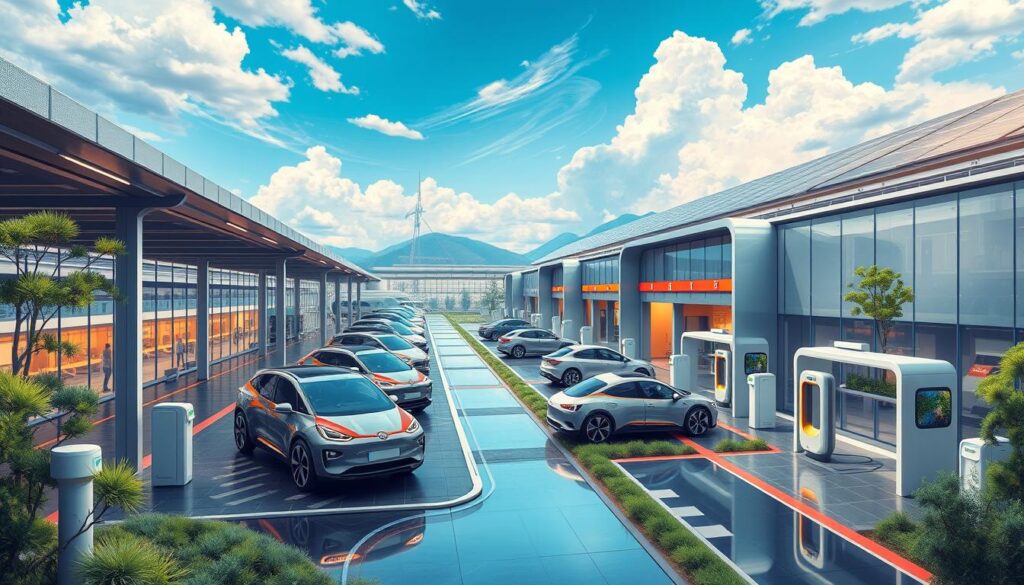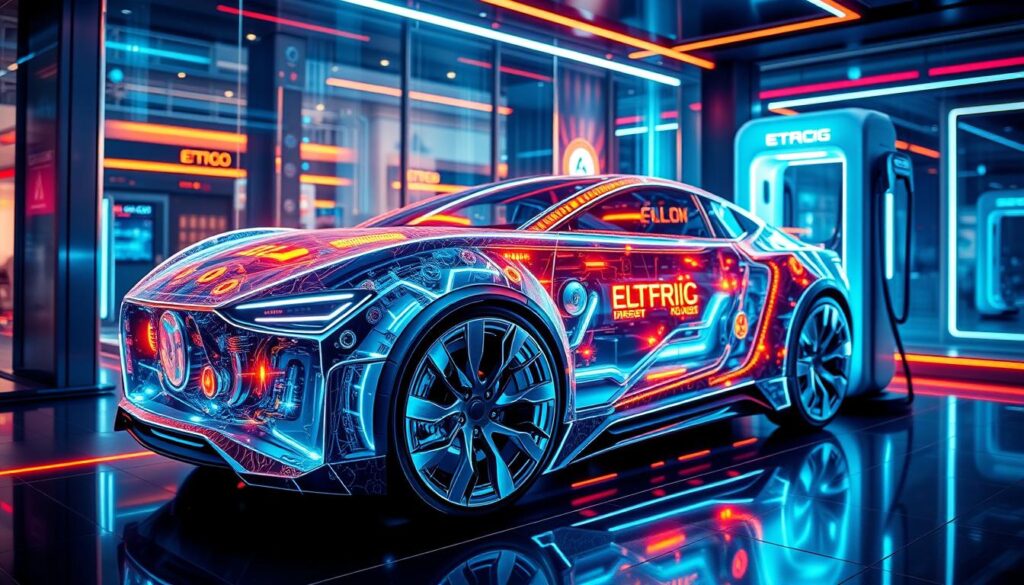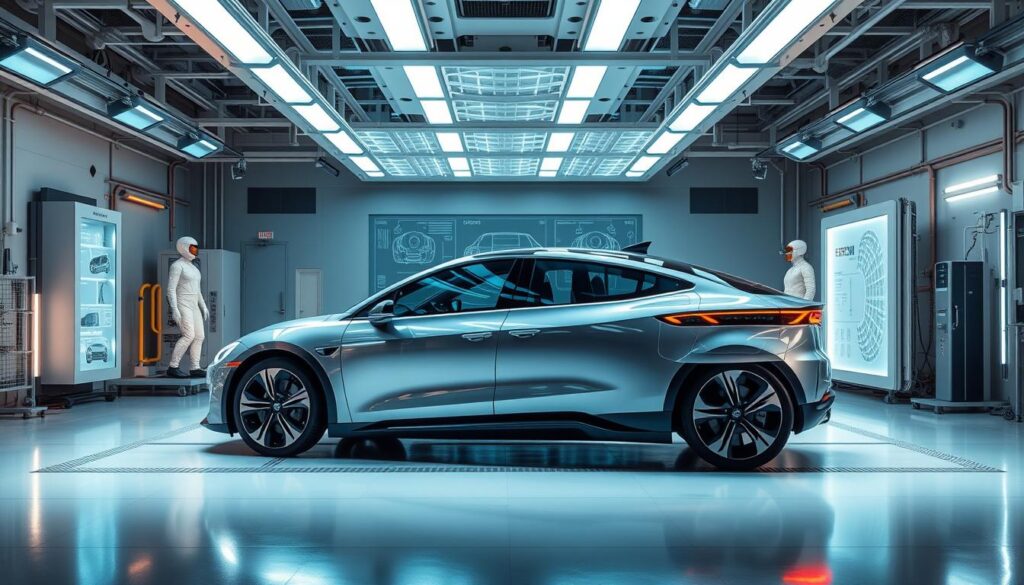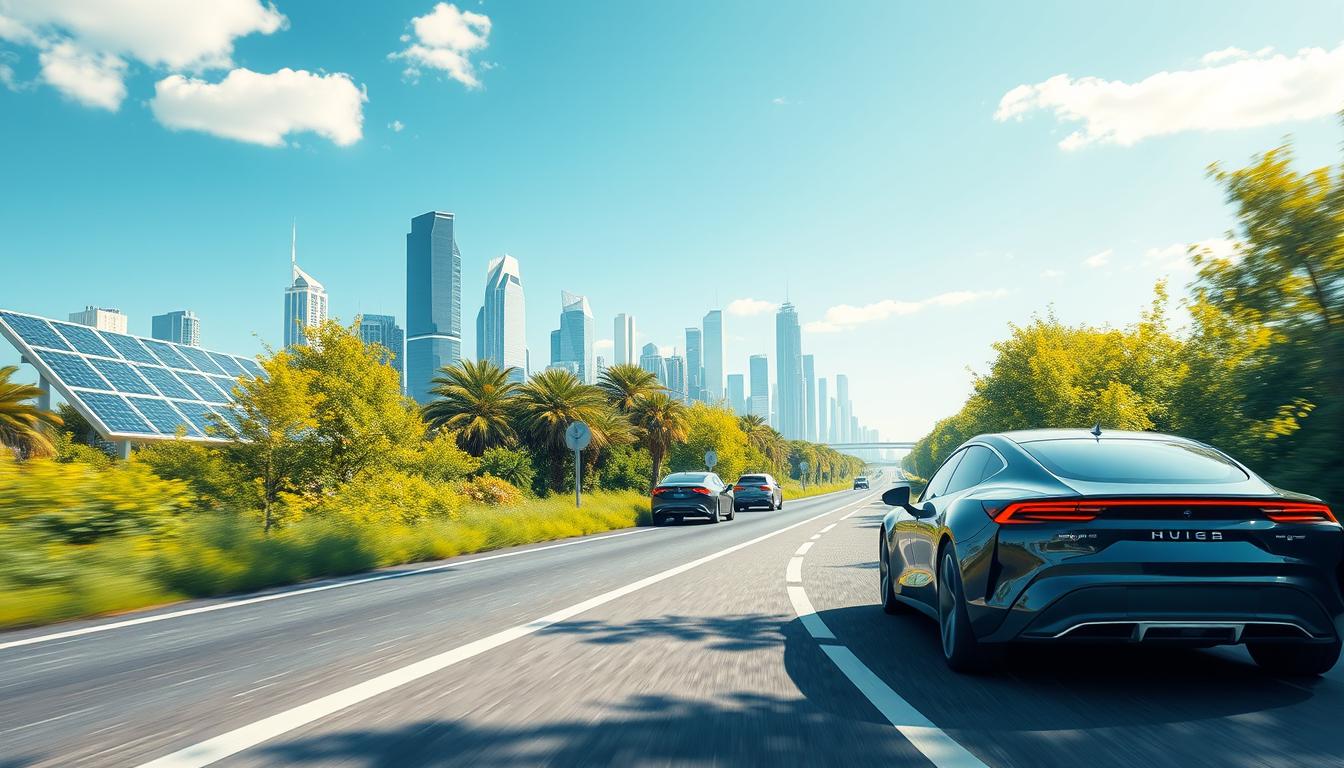
The world is moving towards electric power, and the electric car industry is growing fast. By 2020, over 10 million electric cars were on the roads1. This growth comes from cost savings, environmental benefits, and better performance. Knowing about the electric car industries and design guide helps us understand this shift.

More people want electric vehicles, with 4.6% of new car registrations being electric in 20201. This shows the industry’s growth. The design guide and electric car industries are key to making these cars better and more efficient.
Key Takeaways
- The electric car industries are experiencing significant growth, with over 10 million electric cars on the world’s roads1.
- Electric vehicles account for 4.6% of all new car registrations globally1.
- The design guide is crucial in understanding the current state of the industry and the design elements that contribute to the development of efficient and effective electric cars, including electric car industries and design guide.
- The average one kilowatt (kW) is approximately equal to 1.34 horsepower (HP)1.
- The electric car industries and design guide are essential in optimizing performance and efficiency.
- Understanding the electric car industries and design guide is vital for companies to stay competitive in the market.
The Current State of Electric Vehicle Industries and Design Guide
The electric vehicle market is growing fast. The global market is moving towards electric cars. Companies like Tesla are leading the charge, investing a lot in electric car tech2. This growth has led to a new market for electric powertrains, with many car makers looking to add them to their cars2.
Market growth is expected to keep going up. This is thanks to government help, cheaper batteries, and more people knowing about electric cars’ green benefits2. By 2030, electric cars could save nearly 6 million barrels of oil a day2. The U.S. might see 30 to 42 million electric cars on the road by 2030, needing a big charging network3.
Some important stats about electric cars today are:
- More than one in five new cars sold in 2024 will be electric2.
- Electric vehicles account for around one-sixth of global emissions from road transport2.
- Electric car sales reached nearly 14 million in 20232.
The electric car market is set to keep growing. Key players are pushing for more innovation and investment worldwide2. As the market changes, it’s important to keep up with the latest news and trends in electric cars3.
Core Components of Electric Vehicles
The heart of electric vehicles are electric motors, batteries, and fuel cells. These parts are key to how they work4. Knowing about them helps in making electric cars better and more efficient. Batteries are especially important for how far and how well electric cars can go.
Electric cars use rechargeable batteries made of many cells. These cells turn chemical energy into electricity4.
Electric vehicles have cool features like regenerative braking. This system turns braking energy back into electricity, making them more efficient5. They also have onboard chargers and auxiliary batteries for extra power. The thermal management system keeps everything running smoothly by controlling temperature5.
Electric cars are great for the environment because they don’t emit any pollution5. Their batteries store energy in DC current, which affects how far they can go. The type of motor used also sets them apart from gas cars5. Battery packs are measured by how much energy they hold per pound or cubic inch, showing their power4.
In short, the main parts of electric vehicles are vital for their function and performance. As technology gets better, we’ll see electric cars lasting longer and working better. This makes them a good choice for people looking for a green option4.
Revolutionary Design Elements in Modern EVs
Modern electric vehicles have revolutionary design elements that boost their efficiency and performance. One key aspect is aerodynamic considerations, which help reduce drag and improve range6. This is vital as electric vehicle sales are expected to grow a lot in the next decade6.
Another important aspect is interior space optimization, which makes interiors spacious and comfortable. This is crucial because many EVs are heavy due to their batteries7. The average car carries about 1.2 people for 36 kilometers in cities, showing a need for better car design7.
Some key features of modern EV design include:
- Lightweight materials to reduce energy consumption
- Aerodynamic shapes to minimize drag
- Optimized interior space for comfort and practicality
The electric vehicle market is expected to grow a lot, possibly reaching $800 billion by 20278. As the industry grows, we’ll see more innovation in revolutionary design, aerodynamic considerations, and interior space optimization.
| Year | Projected EV Sales | Market Share |
|---|---|---|
| 2023 | 14 million | 18% |
| 2025 | 20 million | 25% |
| 2027 | 30 million | 35% |
As the industry grows, it’s key to think about the impact of revolutionary design on the environment and what people want. With 70% of potential buyers looking at electric vehicles in 2023, it’s clear the market is moving towards greener options8.
Battery Technology and Range Optimization
Battery technology is key for electric vehicles. Research is ongoing to boost range and efficiency9. Today, we have lithium-ion and advanced chemistries. Charging stations are growing fast to meet electric vehicle demand. People need to be ready to pay more for electric cars than gas ones9.
Improving range is crucial for electric cars. Techniques like regenerative braking and smart battery use help a lot. The electric car market is getting better, thanks to more battery power9. A survey shows people’s choices will decide on plug-in hybrids and full electric cars9.
Charging stations are vital for electric cars. The US thinks recycled materials could help a lot with battery needs by 203010. Making batteries better and cheaper is important for electric cars10. As electric cars become more popular, we need better batteries, range, and charging spots.
| Battery Type | Energy Density | Range |
|---|---|---|
| Lithium-ion | 120 Wh/kg | 300 miles |
| Advanced Chemistries | 150 Wh/kg | 400 miles |

Manufacturing Processes and Sustainability
The electric vehicle industry is moving towards sustainability fast. It’s focusing on green manufacturing processes11. As more people want electric cars, makers are working hard to be kind to the planet. They’re cutting down on waste, using stuff that can be recycled, and making factories more energy-efficient11.
Big steps are being taken, like using solar power and smart energy systems to cut down on carbon emissions11. Also, companies are starting recycling programs for waste and designing cars that can be recycled at the end of their life. This helps create a closed-loop system11. Making electric cars in a way that’s good for the environment is key.
Leaders like Tesla and Volvo are showing the way in making electric cars sustainably. They’re using clean energy and recycled materials11. The use of artificial intelligence (AI) in making cars is also helping save energy and reduce waste11. As the field grows, we can expect even more creative ways to be green and efficient in making electric cars1213.
Performance Metrics and Safety Standards
The electric vehicle industry is growing fast, marking a big change in how we travel14. Electric motors offer quick torque, leading to faster acceleration than gas cars15. This means electric vehicles can go from 0 to 60 mph quickly and reach high speeds.
Safety is a top priority, with electric cars facing the same tough tests as gas cars. They must meet standards like ISO 26262 and SAE J1772 to be safe15. Electric cars also help the environment by cutting down on greenhouse gas emissions and fighting climate change14.
Some important safety features of electric vehicles include:
- Thermal management systems to prevent thermal runaway
- Overcharge protection and thermal shutdown features
- Compliance with regulatory standards such as FMVSS 108 and FMVSS 208
These features help reduce risks from high-voltage batteries and unique electric car systems. They also cut down on environmental harm and boost performance1514.

Future Innovations and Market Trends
The electric vehicle industry is changing fast, with new tech and improvements. Solid-state batteries and better charging systems will make electric cars more efficient and go further16. The market is also growing, with more people wanting electric cars and prices going down.
There are now over 53,000 public charging stations in the U.S., with more than 137,000 charging ports17. This increase in charging spots will help meet the rising demand for electric cars. They are seen as cheaper to run and maintain than gas cars.
Some important trends include:
- More people want electric cars because of new tech and safety
- There’s more money going into charging stations, focusing on quick and easy charging
- Electric car prices are dropping, making them more competitive with gas cars
As the industry keeps moving forward, we’ll see even more new ideas. These will help the electric car market grow and change how we travel16.
Conclusion: The Road Ahead for Electric Vehicles
The future of electric vehicles (EVs) is looking very promising. EVs have moved from the sidelines to the main stage in the car world18. This shift is thanks to better batteries, more charging spots, and government support.
Better batteries will let EVs go further on a single charge18. New solid-state batteries could charge fast and last a long time18. Companies like Tesla and Waymo are leading the way in self-driving EVs18. These could change how we travel and make cities less crowded18.
World governments are helping EVs by offering tax breaks and stricter rules on pollution19. Some places even let EVs use special lanes to speed up travel19. But, as EVs rely more on software, keeping them safe from hackers is key18.
Standard charging systems are also crucial for making charging easy and universal18. Using EVs with solar power can make them even greener18.
As we aim for a greener future, EVs will be key players. The path ahead for EVs is full of hurdles and chances. But with new ideas, government support, and people wanting them, a cleaner, more efficient way to travel is possible.
FAQ
What is the current state of the electric vehicle industries?
The electric vehicle market has grown a lot in recent years. Over 10 million electric cars are now on the roads. Big names like Tesla are investing a lot in electric car tech.
Experts say the demand for electric cars will keep going up. This is because of government help, cheaper batteries, and more people knowing about electric cars’ good for the planet.
What are the core components of electric vehicles?
Electric vehicles have electric motors, batteries, and fuel cells. Knowing about these parts is key to making electric cars better. Batteries are especially important for how far and how well electric cars can go.
What are the revolutionary design elements in modern electric vehicles?
Modern electric cars have new designs that make them better. They are made to cut down on drag, which helps them go further. Inside, they have more room and are comfy.
New materials make them lighter and stronger. This means they use less energy and are more efficient.
How is battery technology and range optimization addressed in electric vehicles?
Battery tech is a big deal for electric cars. Scientists are working hard to make batteries better. This means electric cars can go further and use less energy.
There are more charging spots for electric cars now. Things like regenerative braking help electric cars perform better.
What are the manufacturing processes and sustainability considerations in the electric vehicle industry?
Making electric cars is important for the planet. As more people want electric cars, making them in a green way is key. This means using less waste and being kinder to the environment.
What are the performance metrics and safety standards for electric vehicles?
Electric cars are fast and can go really high speeds. They also have to pass tough safety tests. This makes sure they are safe for everyone.
How they affect the environment is also important. This includes things like emissions and how much resources they use.
What are the future innovations and market trends in the electric vehicle industry?
The electric car world is always changing. New tech like solid-state batteries and better charging systems are coming. These will make electric cars even better.
More people want electric cars, and they are getting cheaper. These trends will help shape the future of electric cars.







